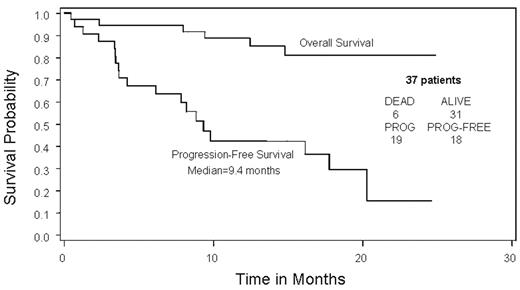Abstract
Background: MM is an incurable disease with an anticipated overall survival ranging from months to decades. Novel therapies like bortezomib have activity in both the relapsed/refractory and up front settings. There are sparse data on whether novel therapies may overcome high risk features.
Methods: Patients with newly diagnosed high-risk myeloma (beta-2 microglobulin [B2M] >= 5.5., plasma cell labeling index [PCLI] >= 1, or deletion 13q) were eligible. Patients were treated with bortezomib 1.3 mg/m2 day 1, 4, 8, and 11 every 21 days for 8 cycles as induction. After induction, patients received bortezomib 1.3 mg/m2 every other week indefinitely. Patients relapsing on maintenance schedule resumed full induction schedule. Responses were defined by the EBMT criteria. The primary end-point was the response rate (90% power to detect a response rate of >=50% ).
Results: Between March 15, 2004 and March 10, 2005, 44 patients enrolled. Among the 43 eligible patients, median age was 63; 51% were male. All had high risk disease: deletion 13q (6/41); PCLI >=1% (17/33); t(4:14) (4/27) and B2M >= 5.5 (34/43). Response data are available for 37 of the 43 eligible patients. The overall response rate was 49% (95% CI: 0.32, 0.66) (0 patients with CR, 1 VGPR, 15 PR, 2 MR, and 11 inevaluable). The response rate allowing for use of serum monoclonal protein levels when a measurable urine monoclonal protein was unavailable at follow-up was 59.5% (1 patient with CR, 1 VGPR, 18 PR, 2 MR, and 6 inevaluable). The median progression free survival is 9.4 months. Thirty-three percent of patients completed the 8 cycles of planned induction therapy and moved to maintenance. Reasons for discontinuing therapy have included progression or death (n=18), adverse events (n=6), and other (n=14). Only 12% of patients remain on active therapy: 0% of deletion 13q patients; 25% of t(4:14) and 12% each of high B2M and high PCLI patients. Of the 14 patients who entered the maintenance phase of treatment, 3 have progressed. Of these 3, 2 took re-induction, and neither responded. Median time to progression for those entering maintenance was12.4 months from the time of starting maintenance. The most common adverse events of grade 3 or higher included neutropenia (33%), diarrhea (31%), hyponatremia (21%), anemia (19%), thrombocytopenia (16%), fatigue (14%). Grade 1–2 sensory peripheral neuropathy occurred in 53% of patients, with only 2% having grade 3 sensory neuropathy. One patient had grade 3 peripheral neuropathy. One patient died after receiving 2 doses of protocol treatment due to heart block and asystole. Updated results on the full study population will be presented at the meeting.
Conclusions: In high risk patients, upfront bortezomib appears to result in comparable response rates to those reported for unselected cohorts of newly diagnosed myeloma patients. Continued follow-up of these patients will provide information about whether this will translate into better overall outcomes.
Disclosures: Bortezomib is not yet approved for first line use in multiple myeloma.
Author notes
Corresponding author


This feature is available to Subscribers Only
Sign In or Create an Account Close Modal